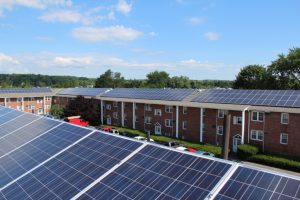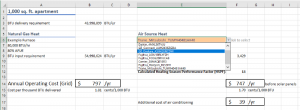The Landlord’s Guide to Reducing Greenhouse Gas Emissions in Rental Properties
By Kimberly Rau, MassLandlords writer and team
Real estate owners, take note: during your next 30-year mortgage, your Massachusetts rental property is more likely than not going to be flooded with rainwater and seawater, leading to mold and structural problems. And that’s on top of the inescapable heat that’s coming your way.
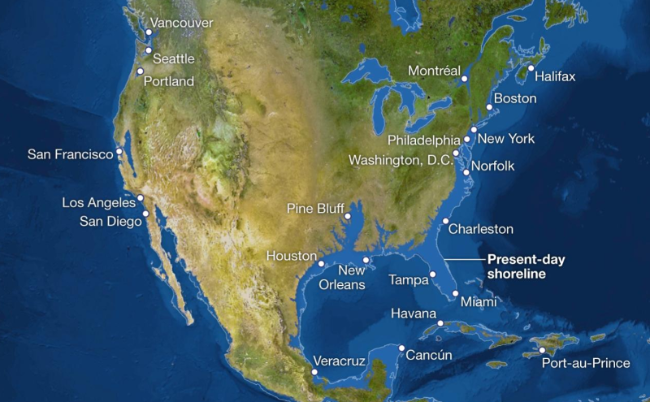
If we don’t follow climate change guidelines, sea levels could rise a maximum of 230 feet, putting large portions of the country – including Boston – underwater. IPCC scientists wrote in the 2021 Physical Science Basis Summary for Policymakers that “Sea level rise greater than 15 m cannot be ruled out with high emissions.”
Image license: National Geographic https://www.nationalgeographic.com/magazine/article/rising-seas-ice-melt-new-shoreline-maps
Sound dramatic? Unfortunately, it’s not. The writing is on the wall for our planet, and it’s not good: either we figure out how to reduce carbon emissions, or we face some nasty effects of global warming and climate change.
If we cannot keep global warming to 1.5–2 degrees Celsius below pre-industrial levels, the effects on the earth will be devastating. Some parts of the world will see an increase in droughts and wildfires.
Warning: Our oceans are warming as if multiple atomic bombs were hitting it every second.
This cannot continue.
Sea levels will rise regardless. The latest report from the Intergovernmental Panel on Climate Change (IPCC) shows that by the end of the century a rise in sea levels of 0.25 meters is inevitable. This will increase flooding, erosion and salinization of water, among other impacts. What we actually experience, especially during storm surge, could be much worse, putting large portions of Massachusetts coastal real estate under water.
To prevent worst case scenarios, 21 countries signed the Paris Agreement in 2016 (the United States dropped out in 2019, but formally rejoined in February 2021), committing themselves to a series of long-term strategies to reduce global gas emissions, focusing on “net zero” emissions by 2050.
To limit global warming, the “built environment’s” energy intensity (that’s how much energy buildings, including apartments and houses, use) must improve by 30 percent by 2030...and that’s just the first step. The more sophisticated we get, and as more people rise out of poverty, we will use more and more energy per square meter. What’s important is using the right kind of energy.
A 30% reduction in fossil fuels by 2030 is just the beginning. To protect the planet, we need to achieve zero percent carbon emissions by 2050. That’s no small feat, and getting there will require effort on the parts of corporations, state and federal government bodies, small businesses and individuals. If we do nothing, carbon emissions for these buildings are expected to double by 2050.
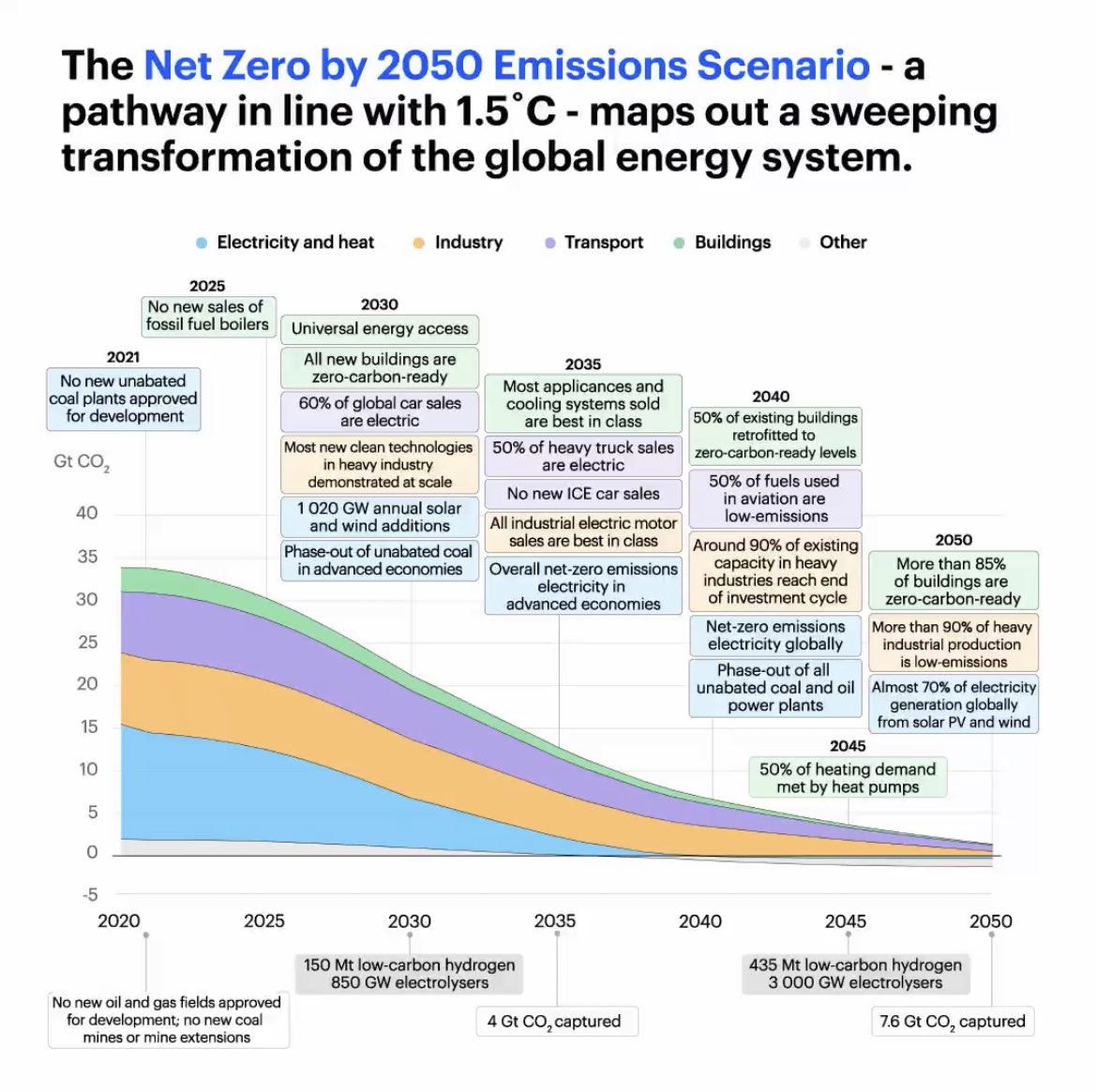
The pathway to “net zero” carbon emissions involves major effort from the government, corporations and individuals, but it’s the only way to slow the effects of global warming.
Image license: The International Energy Agency (https://www.iea.org/reports/net-zero-by-2050)
The following graph from OurWorldInData proves that the US has already decoupled economic growth from carbon emissions. It is possible to grow and emit less.
Can a Landlord Really Help Save the Planet?
In the face of some corporations’ environmental atrocities, it’s easy to think curtailing global warming is too big for a single person to accomplish. However, studies have shown that more than 20% of all U.S. emissions can be directly attributed to household consumption.
To meet the goals that will protect our planet, sales of new oil and gas furnaces must halt by 2025. Massachusetts is one of the states poised to be a leader for climate change policy. You can read the state’s clean energy and climate plan for 2030 here. But while we’re waiting for legislation to change, you can still do your part.
The Fewer Vehicles on the Road, the Better
As a landlord, you may not consider transportation solutions when thinking about your rental’s carbon footprint. But the people renting your apartment probably have at least one vehicle, and if so, they probably drive it to work or school. They use it on the weekend to run errands or take the kids to soccer. What can you do about that?
It turns out, quite a bit.
Install Bike Racks; Advocate for Bike Paths
The less time cars spend on the road, the less emissions they produce. When Boston installed bike lanes, the city saw more people commuting by bicycle, as well as using bikes to attend recreational activities. As part of a comprehensive travel reform plan called Go Boston 2030, the city is looking to further improve its bike lanes through a variety of projects.
If you are a Boston landlord (or a landlord in a city or town that boasts bike lanes or bike paths), consider installing bike racks on your property to encourage your tenants to take advantage of this environmentally friendly option. If you don’t want to (or can’t) install outdoor racks, consider one of several indoor bike storage options.
If your municipality does not offer readily accessible bike paths or lanes, contact your local representatives and see what you can do to lobby for them.
Encourage Walkability and Public Transit
A neighborhood, city or town that is easily walkable is one that is going to see less motor vehicle utilization. You can use the Walkscore website to see how your area fares in terms of walkable access to amenities and services.
One thing that creates walkability is density. Stores, schools and workplaces are going to be harder to simply walk to in areas with low population density. However, in many municipalities, this requires a change in zoning laws to allow for closer homes and multi-family units. Sometimes called “exclusionary zoning,” laws that restrict multi-family construction or have minimum lot sizes cater primarily to affluent populations. You can read more about zoning on our policy page.
Public transportation can also cut down on carbon emissions. Transit-oriented development should be a priority for any new neighborhood development, and not just for the sake of the environment. Better transit scores can lead to better property values.
Install Car Chargers
Electric vehicles are touted as a green way to drive a vehicle but reduce your carbon footprint. It’s true that electric vehicles do have some environmental impacts, but do greatly cut down on harmful emissions.
Installing charging stations for electric vehicles in your home will not only encourage electric vehicle use, but may make your property more attractive to potential tenants. There are a variety of charging options available to you, some of which may not be as costly as you think.
What’s Your Rental’s Carbon Footprint?
The average household in the United States produces 7.5 tons of CO2 equivalents in a single year. In 2019, there were 139 million households in America. That’s a lot of greenhouse gas. Once you’ve examined what you can do to encourage people to avoid driving their cars when possible, it’s time to go inside and look at your rental property from an environmental perspective.
Examine How You Heat and Cool Your Properties
The Center for Climate and Energy Solutions estimates that home heating and cooling creates 441 million tons of carbon dioxide every year. How you keep your rental properties climate controlled can have a big impact on the environment.
A programmable thermostat will keep your rentals at optimal temperatures depending on your tenants’ needs. But ideally, you’d work to eliminate fossil fuels from heating and cooling entirely.
Get Away from Natural Gas
Natural gas has been touted as economical and a better choice than heating a home with coal or oil. And it’s true that natural gas burns “cleaner” than coal and petroleum. But “cleaner” doesn’t necessarily mean “clean,” and burning natural gas is not without risk.
Natural gas is a big source of greenhouse gases being released into the air, not just when it leaks but through normal means of combustion. The methane in natural gas is more potent than carbon dioxide, and natural gas is a non-renewable resource.
There are enough concerns about this fossil fuel that the city of Berkley, Calif., banned the use of natural gas in new construction in 2019. At least one town in Massachusetts has attempted a similar ban, though this was struck down by the attorney general’s office. The attorney general’s office noted that while reducing fossil fuels was an important goal for the state, local regulations could not violate the state building or gas codes.
As of August 2021, the city of Newton was considering a proposal that would require new construction and major renovation projects to eschew fossil fuels and utilize electricity for heating, cooling and water systems.
Solar Energy: Free Heat, Renters Pay
Harnessing the energy of the sun utilizes a free natural resource and is a great alternative to electricity, particularly if your rental unit is positioned in a way to maximize the potential of solar panels. And, solar can add resale value to a building. You can read more about solar energy, including a toolkit PDF and our “Sharing the Sun” webinar at our solar page.
One drawback to solar is that it can be hard to figure out how to charge your tenants for electricity when the electricity is coming from panels on the roof instead of more traditional means. It’s possible, but requires a more indirect process than simply sending your tenants a monthly bill. Our article on how to charge your tenants for solar is a great jumping-off point.
One word of caution: there are some predatory solar companies out there, and some of the ways people are encouraged to fund their solar upgrade can be financially dangerous. Do your homework before signing any contracts.
Design New Builds and Big Renovations Around Heat Pumps
One great way to remove the use of fossil fuels to heat your home is to use a ground source heat pump instead of a furnace. And while these can be expensive to install, the operating costs may even out in the long run. You can use our heat pump vs. furnace calculator to help determine your true costs of running a heat pump. We’ve found that per BTU, heat pumps can be cheaper than natural gas. Our page on heat pumps in rental properties can help you get started.
Additionally, heat pumps can be used for air conditioning in the summer months, which is an attractive amenity for any landlord to offer.
In this same vein, ductless split systems offer heating and AC without the fossil fuels. You can compare and contrast heat pumps and ductless splits to see which may be a better option for you.
Weatherize Your Rental Properties
Drafty windows and doors can really up the cost (both monetary and environmental) of keeping a home cool in the summer and warm in the winter. The writers at energy.gov have a great article on how to “air seal” your home, from doors and windows to electrical sockets and fireplaces. Particularly, energy efficient windows and doors can help lower a home’s energy use.
You also want to look at insulation. You know those houses that always have a nice, clear roof, even when everyone else’s is covered in snow? The owners aren’t up there with shovels. Heat is escaping from the attic and warming the roof, instead of staying in the house where it belongs. A little insulation can go a long way.
And while any kind of energy-efficient upgrade is easier in new construction, retrofits on older homes are not out of the question. Here’s one Massachusetts case study to get you started on your research.
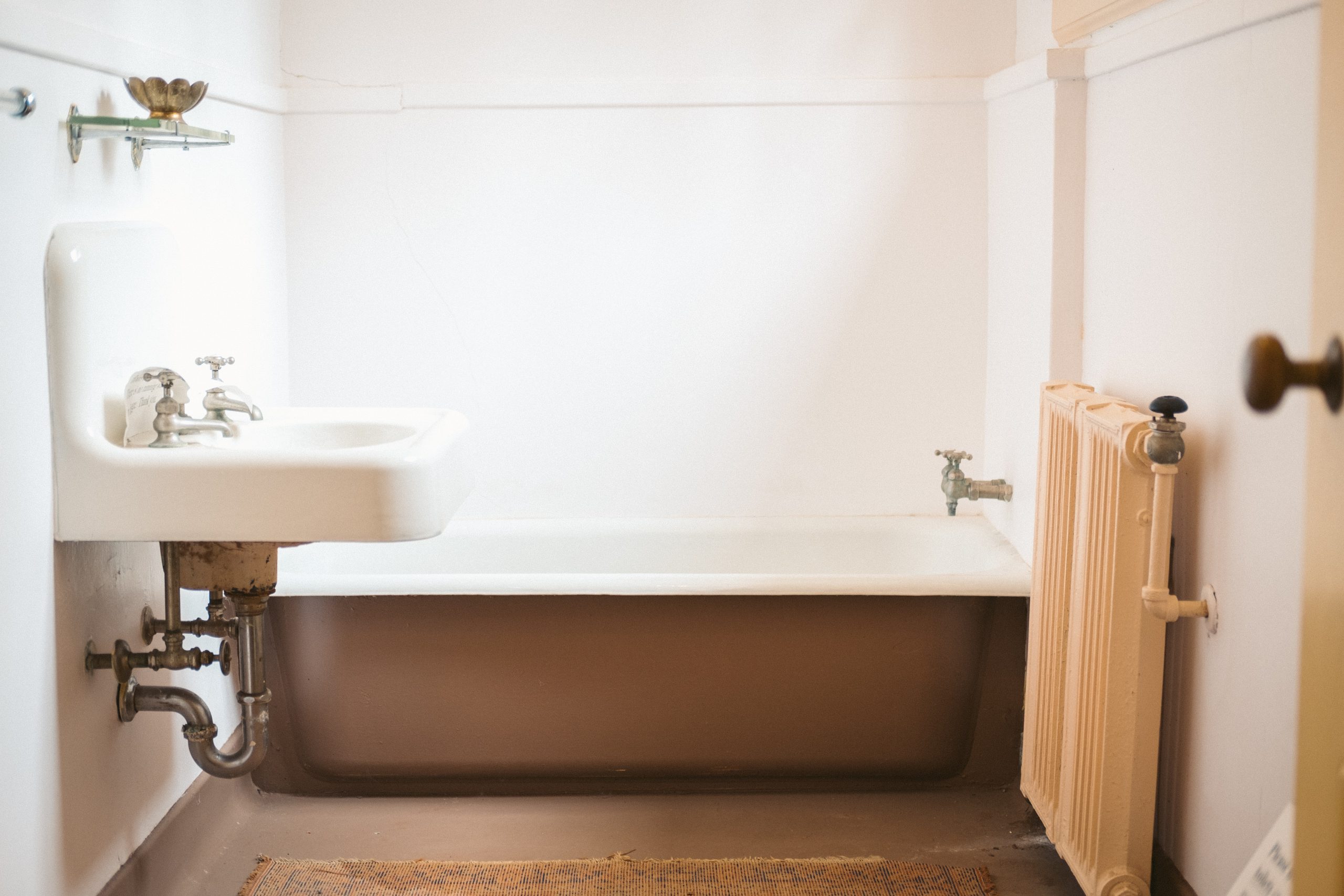
If your bathroom fixtures still look like this, you may be able to save water (and money!) by upgrading to low-flow fixtures. Seeing this is also a clue to would-be buyers that this property will need substantial energy work: insulation, boiler or furnance replacement, and water heater replacement.
Image license: Joshua Bartell for Unsplash
Beware “Energy Vampires” and Other Greenhouse Gas Contributors
Appliances, water and lighting can also impact how environmentally friendly a house or apartment is. You may not have it in the budget to totally replace your kitchen or bathroom fixtures and appliances right away, but there’s still a lot you can do to help the environment and reduce harmful emissions from your rental properties.
Pay Attention to Appliances; Replace Gas Stoves with Induction
Appliances can be energy-efficient, or real energy vampires, sucking up electricity even when they’re not in use. One simple thing you can ask your tenants to do is unplug unnecessary appliances and electrical equipment when not in use (including toasters, coffee pots and phone chargers).
But beyond that, choosing appliances that have the government’s Energy Star rating will help the environment by using less energy. This in turn means lower electricity bills.
If you’re looking to upgrade your appliances, our members-only Home Depot program may help you save money.
Induction stoves are magical. They use electricity rather than gas, so there are no direct greenhouse gas emissions. Also, they heat pots and pans directly, rather than heating a coil under the pan; they are roughly 6 to 7 times faster than an electric resistance stove to boil water, and twice as fast as gas. A set of induction cookware to work on the stove can be purchased for roughly $150.
Optimize Your Water Usage
We all know that conserving water is good for the environment. After all, it takes a lot of energy to move water around, and saving water reduces greenhouse gas emissions. Landlords and homeowners in Massachusetts also know that water in the Bay State is only getting more expensive.
Whether it makes sense for you to utilize water submetering in your multi-unit rentals is something of a personal choice (and, in Massachusetts, comes with a strict set of laws governing it). But there are plenty of other things you can do to reduce water consumption in your home.
A big step that costs nothing is educating your tenants about the importance of water conservation. Encourage them to take shorter showers, turn off the faucet when they brush their teeth and report any leaks or dripping faucets to you or the building manager immediately. A faucet dripping once per second may waste more than 3,000 gallons of water per year. That’s a problem for the environment, as well as your water bill.
Low-flow fixtures such as toilets and shower heads can reduce your water consumption, but you want to make sure this is something you actually need. Otherwise, you could be paying for a fixture that won’t save you very much. The writers at energy.gov have a water usage test you can use for your shower head, along with a lot of other smart ideas for the home. Here’s what you do:
Put a bucket with the gallons marked off under your shower head. Turn on the shower as you normally would, and time how long it takes for the shower to fill your bucket to the one-gallon mark. If it gets there in less than 20 seconds, a low-flow shower head is likely a good investment.
Anyone with fixtures that pre-date 1992 should look into this.
Low-consumption clothes and dishwashers (if your rentals offer these) will also help you reduce your water usage. If your rental can support a dishwasher, you should know that washing dishes by hand can actually use more water than a dishwasher. Just educate your tenants on how to use it best (for instance, only run full loads). Since few people enjoy washing dishes by hand, this will also make your rental more attractive when it comes time to market it.
Good Lighting Choices, Better Energy Consumption
Who remembers being a kid and having a parent constantly reminding them to turn off the lights when they aren’t being used? There are good reasons to conserve electricity that go beyond the electric bill.
Besides reminding your tenants to turn off unnecessary lights and appliances (and unplug the ones you can, such as the toaster, when not in use), consider other ways to cut down on electricity.
Your energy-efficient appliances will help, but if you haven’t made the switch to LED lightbulbs, you’ll want to do that. An article from Tufts states that lighting from incandescent (non-LED) bulbs uses approximately 25% of all electricity in the U.S., most of which is produced by burning fossil fuels.
A Note on Indoor Air Quality
Besides helping the planet in the long run, reducing fossil fuel use in homes can help the people who live in it today.
The quality of the air we breathe inside our homes has become a major topic of discussion, especially after the lockdown periods that kept many inside for far longer than they were used to in 2020.
There are many things to consider when it comes to keeping your living environment as healthy as possible. We should all know by now that smoking inside the home is hazardous for many reasons, and state law requires you to have carbon monoxide detectors if your home has certain types of heating units. But have you considered radon? What about dust? A great resource to ensure your rental homes are as safe as possible is our indoor air quality page. Not only does that help your tenants breathe easier, but limiting air pollutants is environmentally healthy as well.
Heat Pollution is Not a Solution
The future of global warming without serious intervention on our part is bleak. But the good news is, people are starting to pay attention. In 2014, one survey from the Yale Program on Climate Communication showed that only 48% of Americans agreed with the statement, “global warming is mostly caused by human activities.” When asked the same question in 2020, that number stood at 57%. While that’s still not an overwhelming majority, a nine-point jump in six years is noteworthy.
Even more encouraging, when examined on a state level, the majority of people in 46 states agreed with that statement in 2020. The only states that did not, this NBC article noted, were Kentucky, North Dakota, West Virginia and Wyoming, “states with deep ties to energy extraction.”
Divest from Flood-prone Real Estate
Pay attention to the "Flood Factor" when shopping for a new investment. Some properties are now more likely than not to flood. Can you get a return on investment if your building may be rendered unusable? Will you be able to obtain flood insurance to pay for any damage?
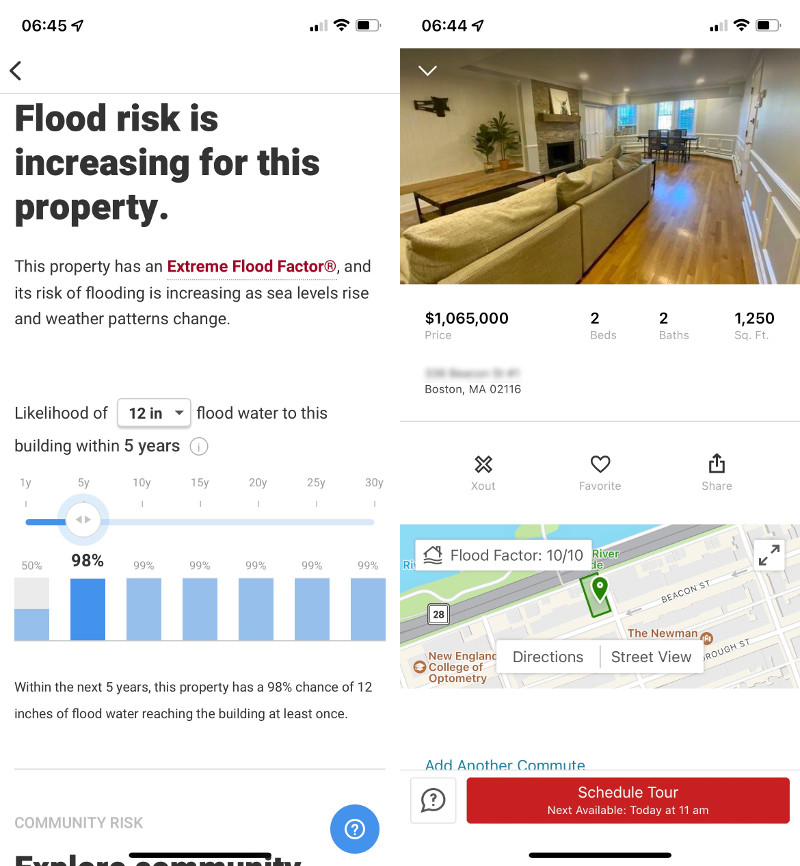
This April 2022 condo listing for Back Bay, Boston, shows a 98% risk of 12 inches of water in the next five years.
If you own a property that is expected to flood, you may want to consider divesting. The best strategy, of course, is not to invest in flood-prone real estate to begin with.

Pluvial flood or "rain flood" is an increasingly common result of climate change, especially far inland. Beaver Brook Park in Worcester, 40 miles from the ocean and 481 feet above sea level, now floods during heavy rain, even if the brook itself does not overflow: the rain falls faster and heavier than we can drain it away. Photograph taken April 8, 2022. CC BY-SA MassLandlords, Inc.
Conclusion
Climate change is inevitable. It’s already happening today. And there’s a lot we must do to halt the devastating effects global warming will have on our planet, particularly the projected shoreline flooding as sea levels rise.
You may not be able to get the powers that be in the fossil fuel industries to admit fault (yet). And you can’t put climate-friendly legislation in place by yourself. But by doing your part to stop global warming on an individual level, and keeping your rental units environmentally friendly, you’ll be helping the planet take a step in the right direction.
The sooner, the better.
Frequently Asked Questions/Frequently Made Comments
I'm skeptical.
We agree! It's okay to be skeptical. It's very hard to come to an independent conclusion on this topic without running into misinformation (accidentially wrong) or disinformation (deliberately wrong).
One place you might try is Skeptical Science. There's no one best place to start, but you might start here and then click around.
Scientists don't really agree.
It's true that scientists don't agree! But it's not true that climate scientists are in disagreement about the causes of climate change. The climate scientists who study this as their fulltime job -- the way we study and learn real estate investment and operations -- have been repeatedly asked, surveyed and polled. You can see the data here.
External Links
- The Massachusetts Energy Efficiency Database
- Students designed a net-zero solar home in one of Colorado’s coldest mountain towns that could help a housing crisis (April 22, 2021)
- Georgetown Climate Center Managed Retreat Toolkit
- NRDC Flood Risk Disclosure Map
- Earth is on track to exceed 1.5C warming in the next decade, study using AI finds (Jan 30, 2023)
- New York City is sinking due to weight of its skyscrapers, new research finds. City is sinking approximately 1-2mm each year on average, worsening effects of sea level rise and flooding threat. (May 19, 2023)
- 2020 environmental justice populations
- Yes, it’s possible to electrify a home on just 100 amps
- Copernicus Copernicus Interactive Climate Atlas (a data visualizer)
- Climate Pulse Visualizer (an easier to follow version of the Copernicus tracker)


